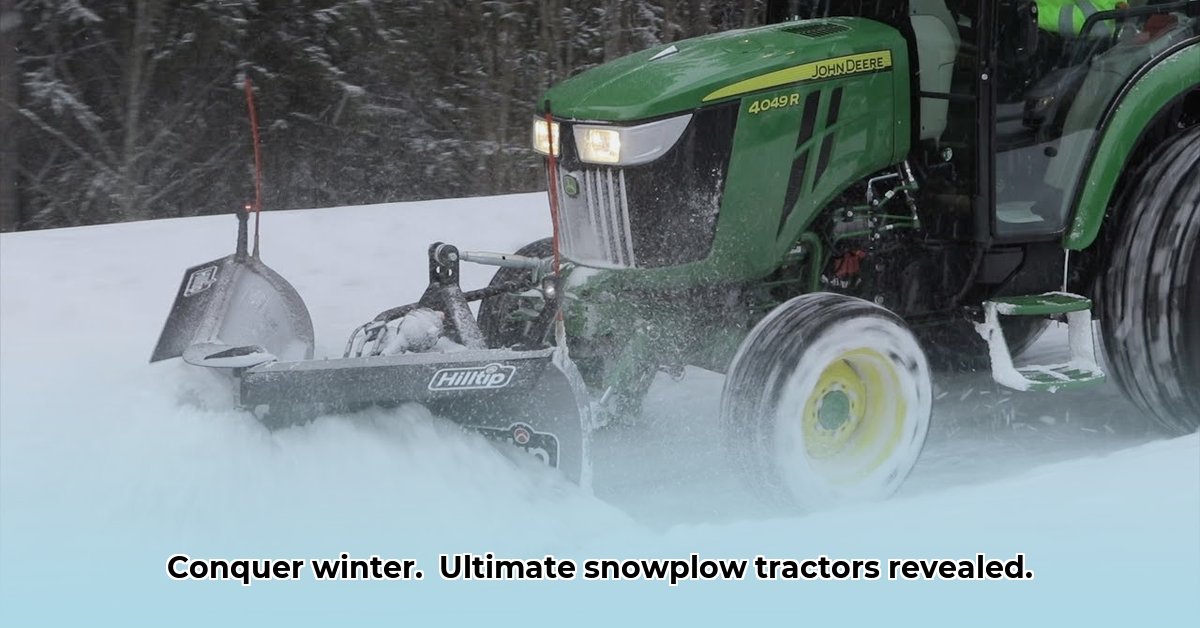
Winter's arrival can significantly hinder farm operations. Efficient snow removal is crucial for maintaining productivity and minimizing economic losses. This article compares two popular tractor-mounted snowplow systems—Western bolt-on and Homestead hydraulic—to help farmers select the optimal solution for their specific needs. We'll analyze installation, performance, cost, durability, sustainability, risk, and regulatory compliance to guide your decision-making process. For more information on 3-point hitch compatibility, see this helpful resource.
Installation and Ease of Use: A Quick Setup vs. Enhanced Control
The Western bolt-on system boasts simplicity. Installation involves directly bolting the plow onto the tractor's front, making it ideally suited for farmers prioritizing a quick and straightforward setup. Conversely, the Homestead hydraulic system requires a third-function hydraulic kit, adding complexity and upfront cost. This added investment, however, unlocks superior control and maneuverability through hydraulic adjustments. The choice depends on your mechanical aptitude and the desired level of control.
Performance: Snow Removal Capabilities Compared
Both systems effectively clear snow, but their performance characteristics differ. The Western plow serves as a reliable all-arounder, particularly well-suited for smaller farms and lighter snowfalls. Its straightforward design facilitates easy removal when the tractor is needed for other tasks. The Homestead hydraulic system, however, is a powerhouse, designed for larger operations and heavier snow conditions. Its hydraulics deliver enhanced precision and aggressive snow-clearing capabilities, making it ideal for substantial snow accumulations and deep drifts. Consider your farm's typical annual snowfall when making your selection. Does your region typically experience light, powdery snow or heavy, wet snow? This will heavily influence which system is most suitable.
Cost Analysis: Initial Investment and Ongoing Expenses
The Western bolt-on system presents a more budget-friendly initial investment. However, the Homestead hydraulic system's upfront cost is significantly higher due to the necessary hydraulic kit. We must also account for long-term maintenance. While the Homestead system offers superior performance, it usually requires more frequent servicing and potential repairs. Additionally, fuel consumption may be slightly higher with the hydraulic system, although precise figures depend on the tractor and operating conditions. Therefore, a thorough cost-benefit analysis is essential, weighing the initial investment against long-term maintenance and operational costs. How much are you willing to spend upfront versus over the lifetime of the snowplow?
Durability and Lifespan: A Long-Term Investment
Both Western and Homestead utilize durable materials in their construction. However, the Homestead system's heavier build and more complex hydraulics suggest a potentially longer operational lifespan. This added durability contributes to the higher initial cost. Consider your long-term investment strategies and maintenance budget when evaluating this factor. A longer lifespan translates to reduced replacement costs over time, influencing the overall cost-effectiveness of each system.
Sustainability Considerations: Minimizing Environmental Impact
Manufacturing any equipment involves an environmental footprint. The Western system's simpler design likely requires fewer materials and less energy during production. However, its potentially shorter lifespan might lead to more frequent replacements, offsetting some initial environmental benefits. Consider the disposal and recycling options for both systems at the end of their useful lives. Currently, more research is needed to quantitatively compare the complete life-cycle environmental impact of each snowplow system.
Choosing Your Plow: A Personalized Guide
The optimal snowplow selection depends heavily on individual farm characteristics. The following guide offers actionable recommendations:
| Farm Size (Acres) | Average Snowfall (inches) | Budget | Recommended System | Considerations |
|---|---|---|---|---|
| <50 | <12 | Tight | Western Bolt-On | Simplicity, ease of use, minimal maintenance |
| 50-200 | 12-24 | Moderate | Evaluate both systems carefully | Balance performance, cost, and skill level |
| >200 | >24 | Higher | Likely Homestead Hydraulic | Superior performance for heavy snowfall justifies higher cost |
Risk Assessment: Identifying and Mitigating Potential Problems
Understanding potential risks is crucial for informed decision-making.
| System | Equipment Failure Risk | Operational Downtime Risk | Financial Risk |
|---|---|---|---|
| Western Bolt-On | Low | Low | Low |
| Homestead Hydraulic | Moderate | Moderate | Moderate to High |
The Homestead system's increased complexity elevates the risk of component failure, resulting in potential downtime and higher repair costs. Regular maintenance is crucial for mitigating these risks.
Regulatory Compliance: Ensuring Safe and Legal Operation
Before purchasing any snowplow, thoroughly research and understand all applicable local and state regulations regarding snow removal equipment and hydraulic system usage. Ensuring compliance is crucial for safe and legal operation.
Conclusion: Selecting the Right Snow Removal Solution
Choosing the optimal tractor snowplow requires a careful evaluation of your farm's specific needs, budget, and operational requirements. By considering the factors outlined in this article, you can select a system that maximizes efficiency and minimizes risks throughout the winter months. Further research into the long-term environmental impacts of each system would provide a more comprehensive understanding.